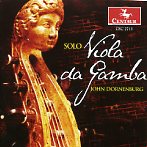For many listeners, Jordi Savall is the undisputed king of this repertoire, and indeed he has contributed reference versions of most of the works on offer here. But John Dornenburg proves absolutely worthy of company with Savall, with his consistently articulate and elegant performances, enlivened by a tone quality and expressive range that’s as close to the human voice as a viol can achieve. Whether it’s the instrument, the engineering, or some combination of both, the viol sound here is warmer and less obtrusive in the lowest register than we often hear from recorded bass viol performances. Thus, it’s easier to listen to long stretches of this one solo instrument than we might otherwise be inclined to. In fact, I happily listened to the program’s entire 67 minutes with only one or two touches of the pause button.
Although Marais and Sainte-Colombe may be the big names on the list of works (Marais’ Chaconne from the First Book of Pièces à une et à deux violes is played completely solo, to fine effect), I found the most striking and overall engaging work to be August Kühnel’s Partita XIII in A minor. This set of dances, composed in the latter 17th century, shows an exceptional mastery of the viol and a real facility for its expressive possibilities, not to mention a sure command of technical challenges–particularly harmonic development and counterpoint–presented in writing for a solo stringed instrument. The result is a work that requires a highly skilled, musically mature player–Dornenburg is both–and one whose thematic and expressive devices occasionally make you wonder whether Bach might have been familiar with Kühnel’s solo-viol creations.
Likewise, Carl Friedrich Abel’s Pieces for Solo Viol–a modern compilation of different movements from Abel’s works to form a “suite”–makes a fine if quite substantial concert work, rich in drama and again demanding virtuoso-level technique, although a couple of the movements are nothing more than sketches that leave much to the discretion of today’s performers. Dornenburg does all the right things here, letting his instrument “sing” and “speak” with a certain tasteful flair that both respects and indulges the viol’s full range. This is a superbly performed and artfully recorded recital that should please viol enthusiasts as well as listeners who want to explore some of the under-exploited yet highly sophisticated repertoire of the 16th and 17th centuries.
































